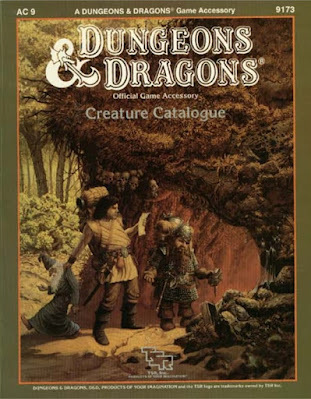Retrospective: Creature Catalogue
 Like a great many players of fantasy roleplaying games – probably most, come to think of it – I am a collector of monsters. The AD&D Monster Manual was the very first RPG product I ever bought for myself and, ever since then, new collections of monsters are usually an easy sell for me. Contradictorily, I'm also largely of the opinion that Dungeons & Dragons has too many monsters. If pressed, I'd walk back that assertion with a variety of cavils and equivocations, in part to justify my continued interest in new books of monsters – I am nothing if not self-justifyingly hypocritical.
Like a great many players of fantasy roleplaying games – probably most, come to think of it – I am a collector of monsters. The AD&D Monster Manual was the very first RPG product I ever bought for myself and, ever since then, new collections of monsters are usually an easy sell for me. Contradictorily, I'm also largely of the opinion that Dungeons & Dragons has too many monsters. If pressed, I'd walk back that assertion with a variety of cavils and equivocations, in part to justify my continued interest in new books of monsters – I am nothing if not self-justifyingly hypocritical. A good example of my hypocrisy comes in the form of 1986's Creature Catalogue. As an avid AD&D player, I believed myself obligated to ritually denounce "kiddie D&D," the truth is that there was a lot of excellent material published for that game line over the years of its existence. I clearly recognized this fact even at the time, because I'd often buy – and use – its modules, accessories, and even boxed sets in spite of my ostentatious repudiation of them.
I rationalized my purchase of the Creature Catalogue on the grounds that it was simply a monster book and that I might find some new foes in its pages with which to challenge the characters of my AD&D campaigns. To be fair to my youthful self, there was quite a lot of truth in my rationalization. It was indeed very easy to make use of elements of D&D – particularly its monsters – in AD&D, which is what I sometimes did. I did this to go effect with several of the monsters from Castle Amber, for instance, so the Creature Catalogue seemed like a solid investment.
In the end, though, I wound up being somewhat disappointed by my purchase. While the book presents more than 200 monsters, a little less than half of them were previously published elsewhere, generally in D&D modules. This was admittedly also true of my beloved Monster Manual II, but less so, since fewer appeared elsewhere and, there's no denying it, the overall quality was better. The monsters of the Creature Catalogue are simply not as good as those of the Monster Manual II, being by turns mundane or silly. There are naturally plenty of exceptions – with so many monsters, it would've been odd if there weren't – but my overall feeling remains that the Creature Catalogue is underwhelming.
The book is divided into distinct sections, each one of which is devoted to a type of monster. Thus, we get a section on animals, another on humanoids, and yet another on "lowlife," the term adopted for vermin monsters. The size of each section varies, with animals and, frustratingly, humanoids being quite numerous and undead – a favorite of mine – being comparatively less so. I say "frustratingly" with regards to humanoids, because it's long been my feeling that D&D could use a lot fewer intelligent, bipedal beings, but I realize this is an unpopular opinion.
Another disappointing aspect of the Creature Catalogue is how many "new" monsters it includes that are translations of pre-existing AD&D monsters into D&D terms. There are nightmares, hook horrors, umber hulks, and ropers, to name just a few. This is admittedly a continuation of a trend begun by the later Frank Mentzer-authored Companion, Master, and Immortal boxed sets, so I can't lay any special blame on the compilers of the Creature Catalogue (Graeme Morris, Phil Gallagher, and Jim Bambra) for it. However, I felt even in 1986 and feel more so now that one of the genuine virtues of the separate D&D line is that it had its own unique flavor distinct from that of AD&D. It was precisely this flavor that regularly got me to sheepishly buy D&D products in the first place. By "crossing the streams," so to speak, TSR was diluting what made D&D worthy in its own right.
The Creature Catalogue is not bad, so much as less good than I had hoped it would be. That's probably an unfair assessment born largely out of my own overblown expectation that it might be a Monster Manual III, but there it is. In general, I like monster books, even idiosyncratic ones like the Fiend Folio. Unfortunately, I can't count the Creature Catalogue among those for whom I have much fondness today and that's a shame. For all my adolescent snobbery, the Dungeons & Dragons line, at its best, offered another imaginative perspective on fantasy roleplaying that I found valuable; that's why I kept buying its releases. For the most part, the Creature Catalogue lacks that perspective. Instead, it feels tired and played out – and that's a genuine shame.
James Maliszewski's Blog
- James Maliszewski's profile
- 3 followers



